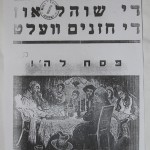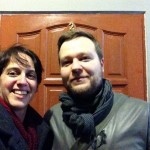Today’s blog is written by Catherine Greenblatt (travel companion extraordinaire and a core member of the film production team)
 For the last 9 days, we have been visiting many sites in Poland that each play some part in piecing together the puzzle of Moshe Rynecki’s life and work. We have relied upon the memoir of his son, George Rynecki, to guide us through the streets of Warsaw. We have also relied upon curators and art historians whose institutions have collected, held, and cared for Moshe’s work. Along our way, we have had some remarkable surprises–several paintings we thought we knew but really didn’t, a newspaper image of a painting we had never before seen–a detailed scene of a passover seder (at right), but was it destroyed or does someone somewhere in the world still hold it?–and a few more puzzles and some enticing leads. These tempting, mysterious fragments spur us on to know more. In the archival records of ZIH (Jewish Historical Institute) and in the MNW (National Museum in Warsaw), we read the names of people who somehow rescued Moshe’s works. And next to their names, dates of sale/purchase: at ZIH: 1946, 1949, 1964, 1984. One of them, from the handwritten ledgers of MNW, is a J. Zebrowski, who sold two watercolors to the MNW in 1963.
For the last 9 days, we have been visiting many sites in Poland that each play some part in piecing together the puzzle of Moshe Rynecki’s life and work. We have relied upon the memoir of his son, George Rynecki, to guide us through the streets of Warsaw. We have also relied upon curators and art historians whose institutions have collected, held, and cared for Moshe’s work. Along our way, we have had some remarkable surprises–several paintings we thought we knew but really didn’t, a newspaper image of a painting we had never before seen–a detailed scene of a passover seder (at right), but was it destroyed or does someone somewhere in the world still hold it?–and a few more puzzles and some enticing leads. These tempting, mysterious fragments spur us on to know more. In the archival records of ZIH (Jewish Historical Institute) and in the MNW (National Museum in Warsaw), we read the names of people who somehow rescued Moshe’s works. And next to their names, dates of sale/purchase: at ZIH: 1946, 1949, 1964, 1984. One of them, from the handwritten ledgers of MNW, is a J. Zebrowski, who sold two watercolors to the MNW in 1963.
Along the way of this project, Chasing Portraits has made a great number of friends through Elizabeth’s tireless and brilliant use of social media. One of them is Piotr Nazaruk who has done a great number of things for Chasing Portraits: he has found archival materials, including
 newspaper articles and images, written a letter in Polish on our behalf, translated some legal materials, and he even traveled to Lublin, where we had the great pleasure of meeting him in person. We spent a lovely afternoon together there and after lunch learned about the work of Grodzka Gate. When Piotr read Elizabeth’s last blog, about this mysterious J. Zebrowski, he did some remarkably quick and excellent research and found some very interesting materials indeed. There was in fact a caricaturist by the name of Julian Zebrowski, somewhat younger than Moshe Rynecki, who lived in Warsaw during the interwar years. Some of his work was anti-semitic, but he apparently had some remorse after the war. Now, when we were visiting the MNW to see the two watercolors there, we interviewed Piotr Ripson, the deputy director of the museum, who is also a great admirer of ZIH and who described the boldness of their exhibition program, providing the example of a recent show of anti-semitic cartoons. Julian Zebrowski was one of the artists featured in that exhibition.
newspaper articles and images, written a letter in Polish on our behalf, translated some legal materials, and he even traveled to Lublin, where we had the great pleasure of meeting him in person. We spent a lovely afternoon together there and after lunch learned about the work of Grodzka Gate. When Piotr read Elizabeth’s last blog, about this mysterious J. Zebrowski, he did some remarkably quick and excellent research and found some very interesting materials indeed. There was in fact a caricaturist by the name of Julian Zebrowski, somewhat younger than Moshe Rynecki, who lived in Warsaw during the interwar years. Some of his work was anti-semitic, but he apparently had some remorse after the war. Now, when we were visiting the MNW to see the two watercolors there, we interviewed Piotr Ripson, the deputy director of the museum, who is also a great admirer of ZIH and who described the boldness of their exhibition program, providing the example of a recent show of anti-semitic cartoons. Julian Zebrowski was one of the artists featured in that exhibition.
Before we leave Warsaw, we hope to fill in a little more of the picture. We know (thanks once more, Piotr!) that Julian Zebrowski died in 2002. If indeed this Julian Zebrowski is the J. Zebrowski in the ledgers of MNW, how did he end up with the paintings? Did he find them? Did he buy them in the interwar years before Moshe hid them? Were they part of one of Moshe’s original eight hidden bundles? Did he find them among the ruins of Warsaw? Are there more? Why did he sell them to MNW, which has no other collection of Moshe’s work? Did he approach ZIH with sale, which did already have an established collection and an overarching mission that centrally includes Moshe’s life and story? And if he did approach ZIH, why didn’t the transaction take place? And then there are questions about Zebrowski’s own life and work: Does he have heirs? Might they have more paintings? Did he have a publishing house? An editor who might familiar be with his work and might know something about his estate? Why would an anti-semite collect Jewish art? What was the nature of his postwar remorse and what form did it take? Does ZIH have archival records about Zebrowski that might reveal information about Moshe?
